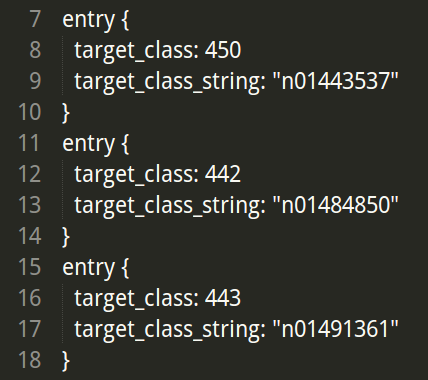接着上一篇文章,上一篇文章中,我们下载了inception-v3的模型,接下来,我们进行简单的迁移学习,将物体进行分类。
下面是代码:
# coding: UTF-8
import tensorflow as tf
import os
import numpy as np
import re
from PIL import Image
import matplotlib.pyplot as plt
class NodeLookup(object):
def __init__(self):
label_lookup_path = 'inception_model/imagenet_2012_challenge_label_map_proto.pbtxt'
uid_lookup_path = 'inception_model/imagenet_synset_to_human_label_map.txt'
self.node_lookup = self.load(label_lookup_path, uid_lookup_path)
def load(self, label_lookup_path, uid_lookup_path):
# 加载分类字符串n***********对应分类名称的文件
proto_as_ascii_lines = tf.gfile.GFile(uid_lookup_path).readlines()
uid_to_human = {}
for line in proto_as_ascii_lines:
line = line.strip('\n')
parsed_items = line.split('\t')
uid = parsed_items[0] # n15092227
human_string = parsed_items[1]
uid_to_human[uid] = human_string
proto_as_ascii = tf.gfile.GFile(label_lookup_path).readlines()
node_id_to_uid = {}
for line in proto_as_ascii:
if line.startswith(' target_class:'):
target_class = int(line.split(': ')[1])
if line.startswith(' target_class_string:'):
target_class_string = line.split(': ')[1]
node_id_to_uid[target_class] = target_class_string[1: -2]
node_id_to_name = {}
for key, val in node_id_to_uid.items():
name = uid_to_human[val]
node_id_to_name[key] = name
return node_id_to_name
def id_to_string(self, node_id):
if node_id not in self.node_lookup:
return ''
return self.node_lookup[node_id]
# 创建一个图来存放google调整好的模型
with tf.gfile.FastGFile('inception_model/classify_image_graph_def.pb', 'rb') as f:
graph_def = tf.GraphDef()
graph_def.ParseFromString(f.read())
tf.import_graph_def(graph_def, name='')
with tf.Session() as sess:
softmax_tensor = sess.graph.get_tensor_by_name('softmax:0')
# 遍历目录
for root, dirs, files in os.walk('images/'):
for file in files:
image_data = tf.gfile.FastGFile(os.path.join(root, file), 'rb').read()
predictions = sess.run(softmax_tensor, {'DecodeJpeg/contents:0': image_data})
predictions = np.squeeze(predictions)
image_path = os.path.join(root, file)
print image_path
img = Image.open(image_path)
plt.imshow(img)
plt.axis('off')
plt.show()
top_k = predictions.argsort()[-5:][::-1]
node_lookup = NodeLookup()
for node_id in top_k:
human_string = node_lookup.id_to_string(node_id)
score = predictions[node_id]
print('%s (score=%.5f)' % (human_string, score))
print()
其中代码 NodeLookup 是类,作用是将inception-v3中1000个分类得分转换成类别的字符串,其中的文件如下所示:
imagenet_2012_challenge_label_map_proto.pbtxt

imagenet_synset_to_human_label_map.txt

从上面的图中可以很简单的看出来。
然后创建一个图用来存放调整好的google存放的权重的图。
with tf.gfile.FastGFile('inception_model/classify_image_graph_def.pb', 'rb') as f: graph_def = tf.GraphDef() graph_def.ParseFromString(f.read()) tf.import_graph_def(graph_def, name='')然后创建会话,在会话中引进softmax的分类器,用softmax分类器进行预测predictions,其中,得到的predictions是二维的,
predictions = sess.run(softmax_tensor, {'DecodeJpeg/contents:0': image_data})
,将图片jped的格式传入。然后np.squeeze得到一维。
最后得到预测值。





















 7754
7754

 被折叠的 条评论
为什么被折叠?
被折叠的 条评论
为什么被折叠?








